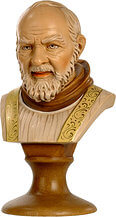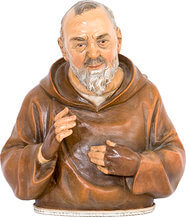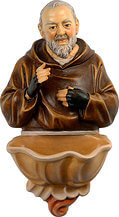
Padre Pio
(5 products)Pio of Pietrecina (1887-1968) is one of the most popular saints in Italy. The Capuchin monk, who became famous not least because of his stigmata, was canonized by John Paul II in 2002 - more shortly after his death than any other saint of the Catholic Church before him.
All prices are including VAT but excluding delivery
Biography
Padre Pio was born in Pietrelcina on 25 May 1887 with the name of Fancesco Forgione. Eighth son of a farmer, he joined the Capuchin Order after school. Already as a child it is said that he cultivated an ascetic lifestyle. The name of the order "Pio" means "the pious". Pio was in poor health since his youth. A tuberculosis disease caused him great anguish. From 1916, after being declared unfit for service because of his illness, Pio lived in the Capuchin monastery of San Giovanni Rotondo.
Since 1910 it is said that the stigmata became visible in Fra Pio: reddening of the skin on the chest, hands and feet, which resembled the wounds of Jesus crucified. The appearance of this stigmatization provoked heated debates within the Church: critics of the popular friar accused Pius of inflicting the wounds through burns. Pio hid his wounds under his gloves and was sometimes even urged not to show himself in public. Although he was bound by an oath of silence, the appearance of these stigmata soon became known to the faithful.
In 1940 Pio began to appear as a healer. He also proclaimed prophecies. Numerous healings have been reported, which could only be explained by a miracle. It is also said that he appeared in several places at once. In addition, he made a name for himself as a fundraiser and with the money collected he was able to open the Casa Sollievo della Sofferenza, at that time a very modern hospital, in San Giovanni Rotondo in 1956.
Padre Pio, despite all the criticism within the Church, was so popular among the faithful that more than 100,000 people came to his funeral in 1968. In 1999 the popular Padre Pio was beatified, in 2002 the canonization followed. After the exhumation of Padre Pio's body, exceptionally well preserved in 2008, since 2010 the relics have been displayed in a separate pilgrimage basilica. September 23 is considered the day of the saint's memory.
In addition to the rumors of self-dramatization and stigmata falsification, Pio has been accused several times of inglorious relationships with women and financial irregularities in the management of donations. These rumors have not damaged Pio's popularity.
Iconografia
Chi vuole acquistare una figura o una statua in legno di Padre Pio troverà qui nel negozio diversi intagli che raffigurano il santo in abito sacerdotale. Pio si riconosce dalle sue sopracciglia cespugliose. Le sculture in legno che mostrano tutto il corpo rappresentano Pio con i guanti senza dita che indossava per nascondere le stimmate.
Adoration
Padre Pio is an extraordinary figure of the Catholic Church. Until today the popular Father is not undisputed. Some scholars of the church define the mystic as hysterical. This scepticism is contrasted by the great popularity of Padre Pio, which he enjoys among the faithful. The Capuchin Order asks for the appointment of Padre Pio as master of the Church.
The veneration of Pio is expressed in different ways. In 2000 a film about the Father was released, which tells the story of Pio's life. The sculptures with the face of Padre Pio are popular among many faithful who turn to the saint to be protected in case of illness or in uncertain life situations.
The mysticism of the Pioneers in particular has a great attraction for many believers in Italy. There are about 400 prayer circles that refer to the teaching of Padre Pio.





